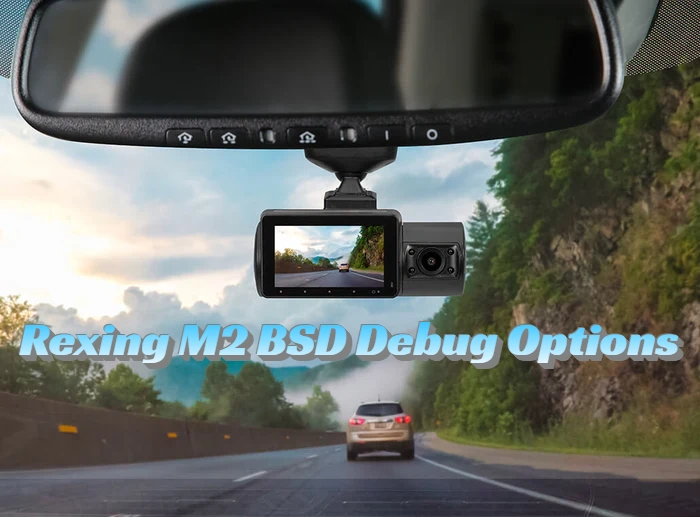Introduction
The Rexing M2 is a widely-applauded dash cam that also has sophisticated features Blind Spot Detection (BSD). The M2 has various BSD debug options to guarantee the highest level of performance and precision. These options allow users to adjust the BSD system’s sensitivity, define monitored areas, and evaluate the system’s effectiveness. This article aims to provide a comprehensive overview of the Rexing M2 BSD debug options PDF and how you can leverage PDF resources to enhance your device’s capabilities.
Understanding BSD Debug Options
Rexing M2 BSD debug options PDF are to some extent utilities that allow a system administrator to explore the M2’s BSD system in detail. By accessing these options, users can:
- Monitor BSD performance: Monitor the ability of the system to recognize the presence of other vehicles in neighboring lanes.
- Adjust sensitivity: Continue to calibrate the BSD system so that the system is not overly sensitive resulting in having too many false alarms, or having too much dead time, where the system does not detect any object at all.
- Modify detection zones: The BSD system has specific regions to search for the vehicle; one can modify them.
Accessing BSD Debug Options
As with many things relating to the M2 and its firmware, the details of what you’re about to do may differ slightly based on your specific board and which version of the firmware you’ve got running. However, the general process typically involves:
- Power on the M2: The power button is located on the right side of the dashcam near the bottom, it is connected to a power source in the car.
- Enter settings menu: Switch to the setting, this button is touch screen most of the time on the home screen there are 4 icons located at the bottom of the phone screen.
- Find BSD options: Look for the BSD settings or the advanced options tabulation in the panel.
- Enable debug mode: The only thing to do is to find an ‘Enable debug mode’ or ‘Advanced settings’ button.
Key BSD Debug Options and Their Functions
Here are some common Rexing m2 bsd debug options pdf and their functions:

- Sensitivity: Determines how receptive the BSD system is to detecting cars; it is the sensitivity control. Increasing sensitivity can potentially detect vehicles at greater distances or smaller than the ground truth, but it also increases the likelihood of false alarms.
- Detection zone width: Defines the range on the sides of the vehicle that the BSD system is working on whether wide or narrow.
- Detection zone distance: Determines the distance from the vehicle from which the BSD system begins with the search of vehicles.
- Filtering: Enables you to exclude specific classes of vehicles, including scooters or bicycles, to minimize the number of false alarms.
- Visual indicators: Used to turn on or off sounds, blinking, and other signals that the system uses to signal about the detected vehicles.
Tips for Optimizing BSD Performance
To get the most out of your rexing m2 bsd debug options pdf system, consider the following tips:
- Experiment with settings: Most of these parameters have specific ranges; experiment with different combinations to achieve maximum sensitivity with the minimum level of false positives.
- Consider driving conditions: Be able to select the type of driving environment you are facing such as city driving or highway driving.
- Monitor performance: Monitor the BSD system effectively and if there is a need correct it.
Advanced Debug Options
In addition to the standard debug options mentioned earlier, some M2 models may offer more advanced features, such as
- Calibration: This case enables you to set the sensors to be able to capture the correct signals. The manufacturer of the device typically provides a calibration tool or procedure for the original calibration.
- Data logging: It helps you to track data of the BSD system, such as sensor data and detection events. This data shall therefore be utilized in analyzing the possible problems or an enhanced performance.
- Firmware updates: Updating the firmware of the M2 frequently ensures new features on the M2, new bug fixes, and performance enhancements such as those related to the BSD system.
Troubleshooting Common BSD Issues
If you’re experiencing problems with your M2’s BSD system, here are some common issues and potential solutions:
- False alarms: Modify the sensitivity of the device, change the area that can be detected or even update the firmware used by the device.
- Missed detections: Tune them up, wash the sensors, or adjust settings and make certain that no particles or barriers are interfering.
- Interference: If other electronic devices are causing the BSD system to be disturbed, then one should relocate the sensors, or to change the cables to shielded ones.
FAQs About M2 BSD debug options
Q: Can I disable the BSD system?
Ans: Yes, as of my knowledge, most M2 models have the provision of turning off the BSD system in case required.
Q: How often should I calibrate the BSD system?
Ans: The manufacturer suggests calibrating the system at least once every six months or if you notice any problems.
Q: Can I install a third-party BSD system on my M2?
Ans: Installing a third-party BSD system, while legal, can void your warranty and potentially damage the M2’s other systems. Therefore, it’s generally not recommended.
Conclusion
The BSD debug options of the Rexing M2 are such that it presents users with the best of both worlds when it comes to safety and speed. If the user comprehends BSD system technology, masters high-precision calibration procedures, and studies data, they can fine-tune the BSD system for the specific vehicle and driving environment.


